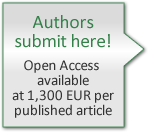Articles
All articles | Recent articles
Numerical Two-Scale Simulations of Damage Evolution at Refractory Materials
D. Henneberg, A. Ricoeur
University of Kassel, Institute of Mechanics, D-34125 Kassel, Germany;
received October 25, 2013, received in revised form January 6, 2014, accepted February 25, 2014
Vol. 5, No. 2, Pages 83-92 DOI: 10.4416/JCST2013-00034
Abstract
Fracture and damage processes on micro- and mesoscale are combined with macroscale simulations applying numerical multiscale approaches. Cracks and grain boundaries are reproduced in cell models that take account of trans- and intercrystalline crack growth. The global, in general thermomechanical boundary value problem is considered within a continuum mechanics framework. Two approaches are presented combining the scales. Simple processes on the smaller level are described in analytical models including the damage evolution into the constitutive laws by internal variables. More complicated microstructural features are incorporated, performing interacting FE simulations on both scales and applying numerical homogenization schemes.
![]() Download Full Article (PDF)
Download Full Article (PDF)
Keywords
References
1 Qin, Q.-H., Yang, Q.-S.: Macro-micro theory on multifield coupling behavior of heterogeneous materials, Springer, Berlin, Heidelberg, New York, 2008.
2 Hill, R.: Elastic properties of reinforced solid, J. Mech. Phys. Solids, 11, 357 – 372, (1963).
3 Lemaitre, J., Desmorat, R.: Engineering damage mechanics, Springer, Berlin, Heidelberg, New York, 2005.
4 Dormieux, L., Kondo, D., Ulm, F.-J.: Microporomechanics, Wiley, New York, 2006
5 Reuss, A.: Calculating the yield point of mixed crystals bases on the plasticity theory, (in German), ZAMM, 9, 49 – 58, (1929).
6 Voigt, W.: The relationship between the two elasticity constants of isotropic bodies, (in German), Wiedemann Annalen, 38, 573 – 587, (1889).
7 Eshelby, J.D.: The determination of the elastic field of an ellipsoidal inclusion and relation problem, P. Roy. Soc. Lond. A Mat., 241, 376 – 396, (1957).
8 Mori, T., Tanaka, K.: Average stress in matrix and average elastic energy of materials with misfitting inclusions, Acta Metall. Mater., 21, 571 – 574, (1973).
9 Zohdi, T., Feucht, M., Gross, D., Wriggers, P.: A description of macroscopic damage through microstructural relaxation, Int. J. Numer. Meth. Engng., 43, 493 – 506, (1998).
10 Zohdi, T., Wriggers, P.: Computation micro-macro material testing, Arch. Comput. Method E., 8, 131 – 228, (2001).
11 Loehnert, S.: Computation homogenization of microheterogeneous material at finite strains including damage, Diss., f. Baumechanik und numerische Mechanik, University of Hanover, 2004
12 Kouznetsova, V.G., Geers, M.G.D., Brekelmans, W.A.M.: Advanced constitutive modeling of heterogeneous materials with gradient-enhanced computational homogenization scheme, Int. J. Numer. Meth. Engng., 54, 1235 – 1260, (2002).
13 Gitman, I.M.: Representative volumes and multi-scale modeling of quasi-brittle materials, Ph.D. Thesis, Delft University of Technology, Netherlands, 2006.
14 Miehe, C., Koch, A.: Computational micro-to-macro transitions of discretized microstructures undergoing small stress, Arch. Appl. Mech., 72, 300 – 317, (2002).
15 Loehnert, S., Belytschko, T.: A multiscale projection method for macro/microcrack simulations, Int. J. Numer. Meth. Engng., 71, 1466 – 1482, (2007).
16 Oezdemir, I., Brekelmans, M.G.D., Geers, M.: FE2 computational homogenization for the thermo-mechanical analysis of heterogeneous solids, Comput. Method Appl. M., 198, 602 – 613, (2008).
17 Geers, M.G.D., Kouznetsova, V.G., Brekelmans, W.A.M.: Multi-scale computational homogenization: Trends & challenges, J. Comput. Appl. Math., 234, (7), 2175 – 2182, (2010).
18 Henneberg, D., Ricoeur, A., Judt, P.: Multiscale modeling for the simulation of damage processes at refractory materials under thermal shock, COMMAT, 70, 187 – 195, (2013).
19 Gross, D., Seeling, Th.: Fracture mechanics, with an introduction to micromechanics, (in German), Springer, Berlin, Heidelberg, New York, 4th edition, 2007
20 Aneziris, C.G., Roungos, V.: Usage of nanotechnology in carbon-bonded refractory, Newsletter, Fire, 2, 4 – 5, (2010)
21 Wachtman, J.B., Cannon, W.R., Matthewson, M.J.: Mechanical properties of ceramics, 2nd edition. John Wiley & Sons, Inc., New York, 2009
22 Barenblatt, B.: The formation of equilibrium cracks during brittle fracture, J. App. Math. and Mech., 23, 622 – 636, (1959).
23 Dugdale, D.S.: Yielding of steel sheets containing slits, J. Mech. Phys. Solids, 8, 100 – 104, (1960).
24 Needelman, A.: A continuum model for voids nucleation by inclusion debonding, J. App. Mech., 54, 525 – 531, (1987).
25 Hillerborg, A., Modeer, M., Petersson, P.E.: Analysis of crack formation and crack growth in concentrate by means of fracture mechanics and finite elements, Cement Concrete Res., 6, 773 – 782, (1976).
26 Rice, J.R.: A path independent integral and the approximate analysis of strain concentration by notches and cracks, J. Appl. Mech., 35, 379 – 386, (1968).
27 Kuna, M.: Finite elements in fracture mechanics, Theory-Numerics-Applications, Springer, 2013
28 Griffith, A.A.: The phenomena of rupture and flow in solids, Phil. Trans. Roy. Soc., 163 – 197, (1920).
29 Skiera, E., Thomser, C., Linke, J., Roungos, V., Aneziris, C.G.: Thermal shock testing of different carbon bonded MgO-C materials by application of an electron beam test facility, Refractories Worldforum, 4, 125 – 129, (2012).
30 Ran, X., Zhu, Z., Tang, H.: Experimental study of the failure criterion for brittle materials in compression, Adv. Mat. Res., 320, 259 – 262, (2011)
31 Krajcinovic, D.: Selection of damage parameter-art or science?, Mech. Mater., 28, 165 – 179, (1998).
Copyright
Göller Verlag GmbH


